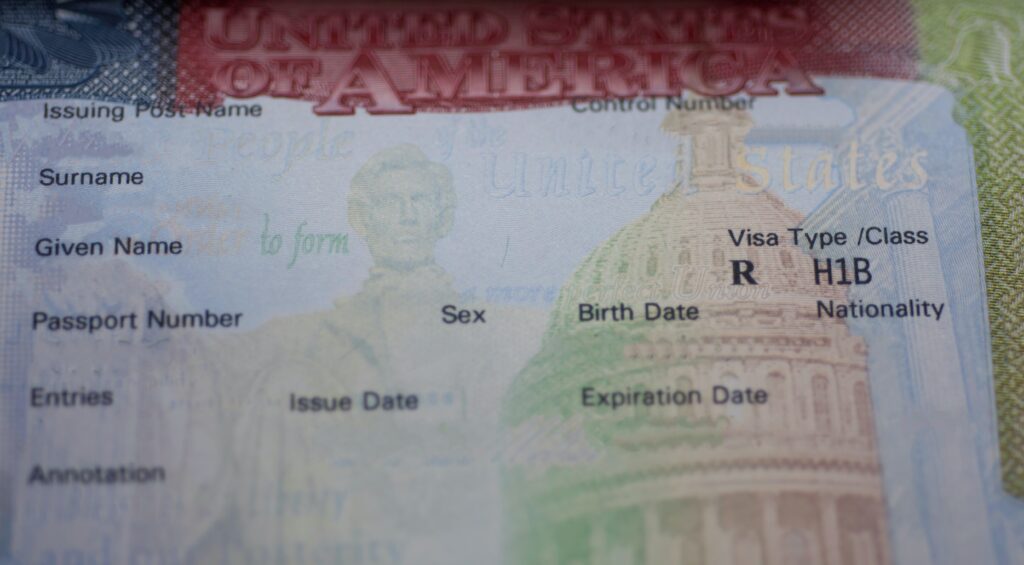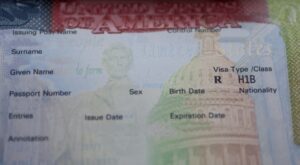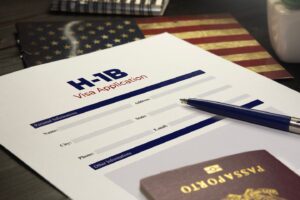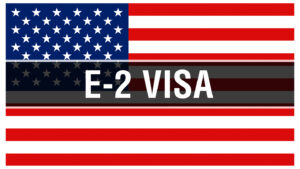Navigating U.S. immigration for work visas can be challenging. The H-1B visa, designed for skilled foreign workers, is a popular choice. Understanding the process of H-1B visas is essential for both employers seeking talent and prospective employees. This guide explores the steps, requirements, and timelines of the H-1B visa application process.
This visa program lets U.S. companies hire foreign workers in specialty occupations requiring theoretical or technical expertise. It’s a non-immigrant visa with dual intent. This means holders can seek permanent residency (a Green Card) while on an H-1B.
The H-1B process has multiple steps, deadlines, and paperwork. The annual cap and lottery system add a degree of chance. This guide provides a clear breakdown of the H-1B process.
Table of Contents:
- Understanding the H-1B Visa
- The H-1B Cap and Lottery System
- Step-by-Step Guide to the Process of H-1B
- Timeline for the Process of H-1B
- Costs Associated with the H-1B Process
- Common Challenges in the H-1B Process
- H-1B Visa Extensions and Transfers
- The Role of Premium Processing in the H-1B Process
- The Impact of COVID-19 on the H-1B Process
- FAQs about Process of H-1B
- Conclusion
Understanding the H-1B Visa
The H-1B is a temporary visa for highly educated foreign professionals. Employers petition for these workers to fill “specialty occupations.” These occupations need at least a bachelor’s degree or its equivalent.
Key Features of the H-1B Visa
- Duration: Up to three years initially, extendable to six. It’s important for international students and other foreign nationals to be aware of this timeframe.
- Dual Intent: Allows pursuing a Green Card. Visa holders interested in long-term opportunities in the U.S. appreciate this feature.
- Job Flexibility: H-1B portability lets workers change employers. The immigration services facilitate this transition while ensuring the individual maintains status.
- Dependents: Spouses and unmarried children under 21 can join the H-1B worker on H-4 visas. This is an important consideration for those seeking to maintain family unity during their time in the US.
The H-1B visa is employer-specific. A prospective petitioner, the employer, must sponsor the foreign worker; individuals cannot apply directly.
The H-1B Cap and Lottery System
The H-1B process includes a cap and lottery system. The U.S. government limits new H-1Bs each fiscal year (FY). There are 65,000 visas for bachelor’s degree holders (regular cap). There are an additional 20,000 for those with U.S. master’s degrees or higher (advanced degree exemption).
Demand often exceeds supply, leading to the H-1B lottery. USCIS randomly selects petitions when they receive more than the yearly quota allows. This is a crucial step for cap petitions as it determines which prospective petitioners will be able to move forward.
The H-1B Registration Process
USCIS launched an electronic registration process in 2020 to simplify cap selection. This process offers prospective petitioners a way to electronically indicate their interest in hiring a specific foreign worker through a USCIS online account.
- Employers or their representatives submit online registrations for each prospective employee. This happens during the designated registration period.
- The registration period typically opens in early March. The dates can be confirmed on the USCIS website during the H-1B registration period.
- USCIS randomly selects registrations if there are more than available visas.
- Selected registrants can then submit a full H-1B petition. If a registration is not selected in a particular year, there’s the option to register again in the subsequent fiscal year’s registration cycle.
Electronic registration lowers initial costs and paperwork. Employers submit full petitions only for chosen registrations. This is a more efficient process for both employers and the USCIS, particularly during times of high demand.
Step-by-Step Guide to the Process of H-1B
Let’s detail each step in the H-1B process.
Step 1: Employer Determines the Need for an H-1B Worker
The process begins with an employer needing a specialty occupation worker. This could be a new or existing position. The role must be a specialty occupation, often needing a specific bachelor’s degree or higher. It’s important for the prospective petitioner to be sure the requirements align.
Step 2: H-1B Registration
For cap-subject positions, the employer registers the potential employee. This occurs in March for the fiscal year starting October 1st. These petitions are considered cap petitions.
Employers use their USCIS online account to complete registration. Accuracy is key, as mistakes could mean denial.
Step 3: Labor Condition Application (LCA)
The employer files an LCA with the Department of Labor (DOL) for selected registrations. This is crucial for H-1Bs, protecting U.S. workers. The LCA helps verify compliance with regulations relating to wages and working conditions.
The LCA includes several employer attestations.
- The H-1B worker will get at least the prevailing wage for the job and area.
- H-1B worker’s conditions won’t negatively impact other similar workers.
- No strikes or lockouts exist in the job category at the work location.
- Current employees have been notified of the filing.
The DOL usually certifies the LCA in seven business days if no errors exist. A certified LCA is a required document when the prospective petitioner decides to file form i-129, and having it in advance can save valuable time.
Step 4: Filing Form I-129
After LCA certification, the employer files Form I-129, Petition for a Nonimmigrant Worker, with USCIS. It includes the certified LCA and documents. These prove the job is a specialty occupation and the worker’s qualifications. The required documentation must demonstrate the need for the H1B worker.
Starting April 1, 2024, USCIS will allow online filing for H-1B cap petitions. This will simplify filing and minimize paper use.
Step 5: USCIS Processing
USCIS reviews the petition. They may send a Request for Evidence (RFE) for more information. Processing times vary; premium processing, for a fee, ensures a response within 15 calendar days. This expedited option is available to employers and individuals alike and offers a significant advantage in time-sensitive situations.
Step 6: Approval and Visa Application
USCIS notifies the employer of approval. If the employee is in the U.S. with another valid status, they can begin H-1B work on the specified date. The new status should be carefully maintained to ensure a seamless continuation of work authorization.
If the employee is abroad, they apply for an H-1B visa at a U.S. embassy or consulate. This involves submitting Form DS-160, application fee payment, and a visa interview.
Step 7: Entry to the U.S.
After visa approval, entry is possible up to 10 days pre-employment start date. A Customs and Border Protection officer decides entry upon arrival. It is important to remember that while the visa is a crucial element in this step, it does not automatically guarantee entry to the US, which is at the discretion of CBP.
Timeline for the Process of H-1B
Understanding the process of H-1B visas and the timeline is important for planning. The registration period and subsequent processes follow a timeline that generally aligns with the start of each fiscal year.
Time | Action |
Early March | H-1B registration period opens. This is a key period for prospective petitioners. |
Late March | H-1B registration period closes. After the closing date, USCIS performs the random selection. |
March 31 | USCIS informs selected registrants. It’s important to watch for the notification. |
April 1 | Earliest filing date for selected H-1B petitions. The April 1st date is significant as it represents the official beginning of the filing season for H1-B cap cases. |
April – September | USCIS processes H-1B petitions. USCIS assesses submitted materials, including any RFE responses and other required documents. |
October 1 | Earliest new H-1B employment start date. It aligns with the commencement of the new government fiscal year. |
These dates may change slightly annually. Check the official USCIS website for the latest details.
Costs Associated with the H-1B Process
Employers usually pay H-1B fees. Maintaining accurate and updated information about the process of h1b fees is vital.
- H-1B Registration Fee: $10 (as of 2024)
- Base Filing Fee for Form I-129: $460
- ACWIA Fee: $750 (1-25 employees); $1,500 (larger employers)
- Fraud Prevention and Detection Fee: $500
- Public Law 114-113 Fee: $4,000 (certain employers only)
- Optional Premium Processing Fee: $2,500
Fees can change. See the official USCIS fee schedule for updates.
Common Challenges in the H-1B Process
Though seemingly straightforward, the H-1B process can be complicated. Understanding these challenges can better prepare petitioners.
1. Meeting the Definition of a Specialty Occupation
USCIS reviews petitions thoroughly. They check if the position requires specialized knowledge and a bachelor’s degree or equivalent. Demonstrating the job truly needs specific skills and expertise is key.
2. Proving the Beneficiary’s Qualifications
Foreign degrees may need evaluation to confirm U.S. equivalency. This process requires detailed documentation.
3. Timing Issues
The H-1B process has strict deadlines. Missing these can cause delays until the next fiscal year. Careful planning is important.
4. Requests for Evidence (RFEs)
USCIS may issue RFEs. Prompt and thorough responses are vital to avoid delays or rejections. RFEs add complexity to the petitioning process and emphasize the importance of careful documentation at the outset.
5. Maintaining Status
For those in the U.S., keeping a valid status throughout is essential. Any lapse can impact the petition process negatively. This is especially pertinent for those with existing immigration statuses seeking a change of status.
H-1B Visa Extensions and Transfers
The process of H-1B doesn’t stop at initial approval. Extensions and transfers are often necessary.
H-1B Extensions
H-1Bs are valid for three years, renewable for another three, totaling six. Extensions beyond six years may be allowed for those pursuing a green card. Those with Optional Practical Training (OPT) who have used all of their eligible time might find the option of an H-1B extension very attractive if their educational and occupational trajectories align with H1B sponsorship. Curricular practical training (CPT), which offers practical experience, can complement their pursuit of a degree that might qualify for H-1B status in the future.
Extending requires filing a new Form I-129 before the current status expires. It’s best to apply at least six months in advance. It is advisable to consult with experienced immigration professionals or reference USCIS announcements about specific timelines.
H-1B Transfers
H-1B portability lets workers switch employers. The new employer files a non-frivolous H-1B petition. The H-1B worker can start with the new employer once the petition is filed, given certain conditions are met. Portability is a key feature of H-1Bs that distinguishes it from certain other visa categories.
- Lawful U.S. admission.
- New petition filed before authorized stay ends.
- No unauthorized employment history.
This allows for career progression while maintaining visa status.
The Role of Premium Processing in the H-1B Process
Premium processing offers faster processing for a fee. USCIS guarantees a response (approval, denial, or RFE) within 15 calendar days. Understanding what falls under the realm of premium processing, compared to other standard or expedited options, is key for navigating this process effectively. The same process for initial petitions is used for any H-1B extensions.
Premium processing helps in these cases:
- Expiring current status.
- Urgent job needs.
- When a definite processing timeframe is needed. It allows both employers and employees to effectively manage their professional transitions.
File Form I-907 with the fee. Premium processing expedites USCIS response but does not ensure petition approval. Note that premium processing has certain parameters that might change occasionally, according to announcements from USCIS.
The Impact of COVID-19 on the H-1B Process
COVID-19 impacted immigration, including H-1Bs. Some changes include increased remote work options for H-1B visa holders. Additionally, there are electronic signatures allowed and potential visa processing delays.
Staying updated on the latest guidance from USCIS and the Department of State is important.
FAQs about Process of H-1B
What is the process of an H-1B visa?
The H-1B process involves several steps. It begins with employer registration. Next comes selection in the lottery if needed, and a Labor Condition Application. Then filing Form I-129 with USCIS, and the employee getting a visa stamp (if outside the U.S.). For those already in the U.S., a change of status within USCIS is done, rather than going to an embassy or consulate abroad. It’s crucial for petitioners to understand the nuances.
How long does the H-1B process take?
The H-1B process varies in length. Registration is typically in March, filings in April. Standard processing takes 2-4 months. Premium processing gets a response within 15 calendar days. This response might be a request for evidence from USCIS, so approval isn’t always immediate. Many use premium processing because of the much faster processing time, despite it not necessarily resulting in final approval right away. The timeline has a major impact on students’ OPT decisions.
Does H-1B lead to Green Card?
The H-1B is non-immigrant but dual intent. Holders can apply for permanent residency (Green Card). The Green Card process is different with extra steps.
Who is eligible for the H-1B visa?
H-1B eligibility depends on the job and applicant’s skills. The job must be a specialty occupation. Usually, this requires at least a bachelor’s degree. Applicants need that degree or equivalent experience. Many applicants hold Master’s or other advanced degrees. Having a higher degree improves one’s chances in the H1B lottery. This includes advanced degrees, such as master’s and doctorates.
Conclusion
The process of H-1B visas is multi-faceted, with many steps and deadlines. Understanding each step helps employers and employees succeed. Each stage requires careful attention and compliance with USCIS rules. A clear understanding from both parties is beneficial.
The H-1B program is a way for U.S. companies to find talent and foreign workers to contribute. Being informed and seeking expert help when necessary are beneficial. Getting an H-1B visa doesn’t conclude the journey, there’s much more.
Maintaining status, extensions, transfers, and aiming for permanent residency are part of the process of an H-1B visa. Patience, diligence, and a good understanding of the requirements can lead to H-1B success.




